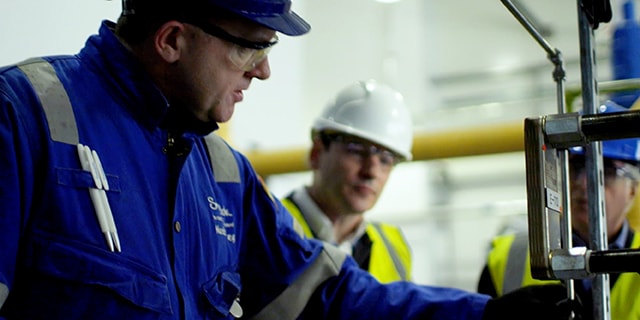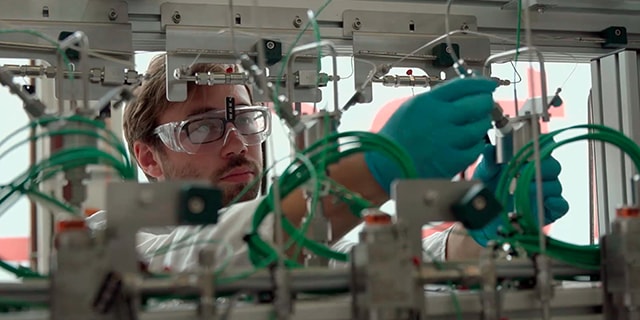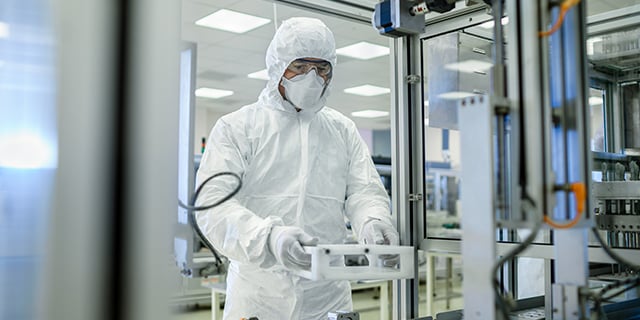Building a More Profitable Semiconductor Fab

Why High-Performing Fluid Systems Matter in New Semiconductor Fab Construction
Masroor Malik, Market Manager, Semiconductor
When building a new semiconductor fabrication facility (or “fab”), there are many considerations, including speed to market, material and installation standardization, and cost. Many estimates put the cost of building a new fab over $1 billion. Values as high as $3 – 4 billion are not uncommon, and some of the largest fabs may soar past $10 billion.
Cleanrooms and the expensive microchip fabrication equipment make up the bulk of these expenses, but total cost of ownership can be highly influenced by other systems and equipment throughout the facility.
Fluid management systems, which function essentially as the fab’s circulatory system by transporting liquids and gases where needed throughout the facility, are one such example. When approaching new semiconductor fab construction, there is significant opportunity to contribute to the fab’s short- and long-term profitability by specifying high-quality fluid system components and assemblies, and by working closely with fluid system suppliers during the front-end engineering and design (FEED) stage of development.
Here are five ways taking a careful approach to designing and installing fluid systems can contribute to a more profitable fab:
 #1. Faster, Leak-Tight Installation
#1. Faster, Leak-Tight Installation
New fab construction is typically indicative of new production technology and/or capacity expansion, making speed to market a primary objective to stay ahead of the competition. Semiconductor manufacturing and production is expected to begin as soon as possible—in some cases, possibly before the entire facility is finished.
Put simply, there is no time to waste. But designing and constructing complex fluid systems and routing them throughout the fab can be a time-consuming process, involving a significant amount of labor and expertise to properly bend the appropriate tubing, install critical components, and ensure total system integrity. This process can be especially difficult if contractors and installers do not have the proper knowledge or training to assemble highly reliable, leak-tight systems.
Custom engineered and prefabricated fluid system assemblies can help eliminate installation issues during construction and remove a significant amount of labor involved in assembling complex subsystems. Look for a supplier that will work to understand your needs and that can provide a complete, easy-to-install assembly made with high-quality components. The time saved can help your fab become fully operational that much faster, enabling full-scale semiconductor production to begin.
 #2. More Efficient Planning and Design
#2. More Efficient Planning and Design
Fab fluid systems are comprised of a variety of components, including tube fittings, valves, regulators, hoses, and tubing. Proper system planning, efficient design, effective tube routing, and other installation best practices can help contribute to a system that is up and running faster and will be able to perform reliably for the facility’s lifetime.
For example, a subsystem that requires a complex series of tubing directional changes can pose a challenge for in-house designers or installers. Working with a supplier that provides a complete subassembly can once again be a valuable asset, as tube bends will have been performed offsite. The complete subsystem will be ready to install and leak-tight upon delivery.
Elsewhere, an efficiently designed fluid system may incorporate numerous tube bends where additional fittings may have been otherwise used. Reducing unnecessary connection points can help save the fab builder money on extra parts, and also by eliminating potential leak points. Manufacturers can drive down short-term costs during construction, as well as the total cost of ownership over the life of the facility, by specifying higher-quality fluid system components and relying on fluid system design and service experts for support where needed.
 #3. Reduced Total Lifecycle Costs
#3. Reduced Total Lifecycle Costs
Once the fab is in production, operational efficiency and maximized throughput are priorities. Any downtime resulting from a fluid system failure can mean significant financial loss for every hour production must be shut down. Sourcing high-quality components and assemblies at the start of the process can be help eliminate maintenance, repair, and operations (MRO) requirements over the life of the facility.
For example, fabs use powerful chillers to maintain optimal temperature stability in manufacturing processes. However, if a coolant transport hose is not outfitted with the proper insulation, temperatures in the tool chamber may fluctuate, presenting a challenge to maximum production output. Selecting the right type of insulation in hoses from the outset can help reduce the likelihood of any issues, including condensation, which is common in a fab environment.
Choosing high-quality components and well-designed systems at the outset of construction will allow for easier and less time-consuming MRO activities. Additionally, fewer necessary component and application replacements will be required over time. The savings and reduced downtime achieved can help the facility remain more productive—and more profitable—for the long-term.
 #4. Standardized, Global Quality
#4. Standardized, Global Quality
Fab owners must often consider how to best replicate standards and processes across multiple global locations to ensure maximum production viability and maintain quality requirements.
Standardized fluid system components and applications throughout all facilities can be beneficial. Consistent systems will contribute to easier maintenance, better continuity of installation techniques, and overall safety of production operations. Finding suppliers with global construction services, including worldwide supply chain capabilities and local support can help fab builders reduce overall procurement and spending costs. Working with these organizations across facilities can lead to efficiencies and design choices that yield sizable profitability improvements worldwide.
 #5. Increased Productivity and Throughput Yield
#5. Increased Productivity and Throughput Yield
Once a fab is commissioned and operational, high-quality fluid systems that eliminate the need for ongoing maintenance and downtime can contribute to higher levels of productivity and viable chip yield by providing millions of uninterrupted, ultra-high purity-level clean production cycles. Production reliability can help a producer gain or maintain their edge in this highly competitive industry.
When commissioning a new fab, minimizing upfront component costs while sticking to ambitious construction timelines are among the most important goals for a builder. But as we have seen, sourcing higher-quality parts, components, and subassemblies for critical fluid systems throughout the fab can contribute to numerous benefits and overall lower cost of ownership for the lifetime of the facility.
Interested in learning more? Swagelok has helped semiconductor producers design and build fluid systems around the world. Get in touch with our teams to find out how our design and assembly services can help with the construction of your next fab.
Related Articles

Tackling Practical Performance Issues in Fluid and Sampling Systems
Learn practical tips on how to improve the performance and accuracy of your fluid and sampling systems from Swagelok.

Q&A: Semiconductor Manufacturing Past, Present, and Future
Find out how collaboration between semiconductor tool OEMs, microchip manufacturers, and fluid system solutions providers has enabled the semiconductor market to keep up with the demands of Moore’s Law for decades, and where we go from here.

Solving Semiconductor Fabrication Challenges with Insulated Hoses
The right insulated hose solution can help solve some common challenges associated with the highly precise semiconductor fabrication process.

